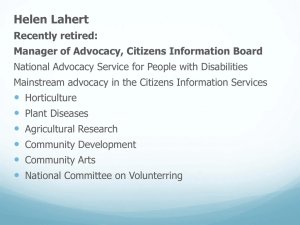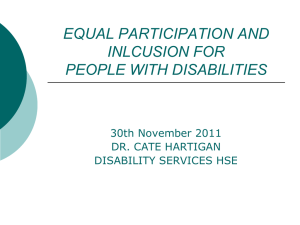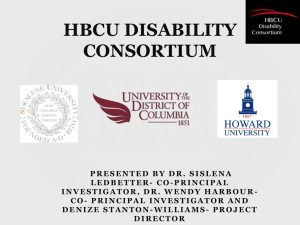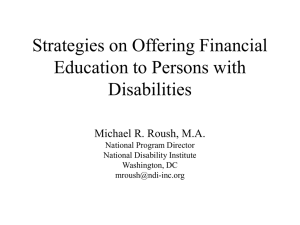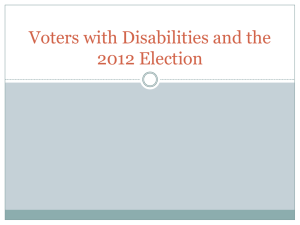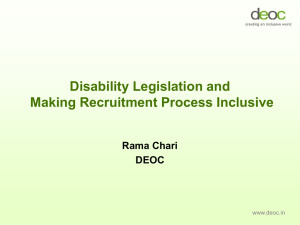Planning for Postsecondary Education - MAST
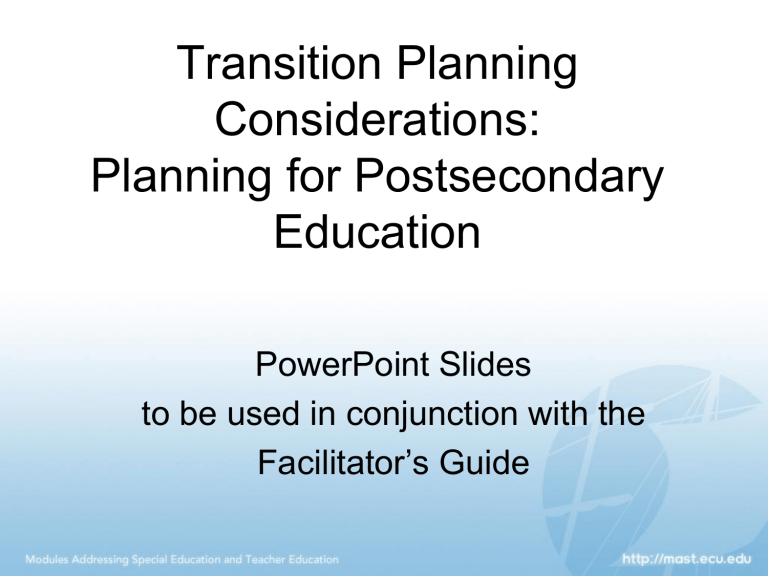
Transition Planning
Considerations:
Planning for Postsecondary
Education
PowerPoint Slides to be used in conjunction with the
Facilitator’s Guide
Copyright © 2012, East Carolina University.
Recommended citation:
Johnson, E. & Henderson, K. (2012). Transition planning considerations: planning for postsecondary education – A
PowerPoint presentation for professional development.
Modules Addressing Special Education and Teacher
Education (MAST) . Greenville, NC: East Carolina
University.
This resource includes contributions from the module developer and MAST Module Project colleagues (in alphabetical order) Kelly Henderson (Facilitator Guide
Editor), Tanner Jones (Web Designer), Diane Kester
(Editor), Sue Byrd Steinweg (Project Director), Bradley
Baggett (Graduate Assistant), and Sandra Hopfengardner
Warren (Principal Investigator).
Session Agenda
• Introduction
• Session Goal and Objectives
• College Growth
• Differences Between High School and
College
• Key Points to remember
• Student Reflections on Transition Part 1
• Planning for Self-Advocacy
Session Agenda, continued
• Planning Ahead: Coursework for College
• Planning Ahead: Psychoeducational
Evaluations
• Planning Ahead: College Entrance
Examinations
• Planning Ahead: Getting Started with
Assistive Technology (AT)
Session Agenda, continued
• Planning Ahead: College Research
• Student Reflections on Transition Part 2
• High School/College Contrasts
• Student Reflections on Transition Part 3
Summary
• Evaluation
Introduction
• Let’s begin by getting a glimpse of two college freshmen discussing their experiences in the postsecondary setting.
• Watch the video at http://mast.ecu.edu/modules/tpc_ppe/lib/ media/intro-video.html
.
Activity - Introduction
• In small groups, brainstorm a list of the social and academic challenges they faced or faced by young adults you know as they transitioned to college.
• Once listed, consider how each of those challenges might differ for young adults with learning disabilities.
Session Goal and Objectives
• The goal of this module is to explore the issues that high school students with learning disabilities often encounter as they transition from high school to postsecondary education and to provide steps educators can take to facilitate this transition.
Session Objectives, continued
Session Objectives-
The participant will be able to
• Identify key differences between disability support services in K-12 and postsecondary education and the relevant legislation that underlies these differences;
Session Objectives, continued
• Identify key differences between the educational experience in the high school and postsecondary environments and related recommendations for students to facilitate a smooth transition from high school to college;
Session Objectives, continued
• Identify common transition issues for students with learning disabilities and suggestions for how educational professionals can address these issues as part of a comprehensive transition plan for college-bound students with learning disabilities.
College Growth
• In years past, attending college was an unattainable goal for students with learning disabilities.
• Even today, only a small percentage of students with learning disabilities (LD) earn a college degree.
College Growth, continued
• However, continuing trends include increased college enrollment and improved programs and services for students with disabilities at many universities.
• More students with LD will likely choose to pursue postsecondary education.
College Growth, continued
• Since students with LD tend to struggle academically in the college environment, there is great need for solid transition planning at the high school level.
• This session will provide a basic overview of the issues that students with LD commonly encounter as they plan for college as well as some tools you can use to assist them with their preparations.
Activity - College Growth
• Explore the federal laws applicable to students with learning disabilities in the K-
12 and college/university environments by reviewing the these websites:
– Building the Legacy 2004: http://idea.ed.gov/
– U.S. Department of Health and Human
Services: http://www.hhs.gov/ocr/civilrights/resources/fac tsheets
Activity - College Growth, continued
– Locate information about how the Individuals with Disabilities Education Act (IDEA), the
Americans with Disabilities Act (ADA), and
Section 504 of the Rehabilitation Act protect postsecondary students with disabilities from discrimination.
– Brainstorm what these protections might mean on a daily basis for young adults with disabilities transitioning from high school to their first postsecondary education experience.
Differences between High School and College
• Let’s examine the difference between disability support services in high school and college.
• These contrasts will provide background information and explain the underlying origins of many of the transition issues that students with disabilities often encounter.
Differences, continued
Disability Services Legislation
High School College
IDEA (Individuals with Disabilities
Education Act of
2004)
Section 504 of the
Rehabilitation Act
ADA (Americans With
Disabilities Act)
Section 504 of the
Rehabilitation Act
Differences, continued
• Disability services differ in high school and college because these supports are mandated by entirely different legislation.
– In K-12, students with disabilities are primarily served under the Individuals with Disabilities
Education Act – IDEA, renewed in 2004.
Differences, continued
– Under IDEA, school districts must provide all children with disabilities a free, appropriate public education that integrates them into general education classes as much as possible while fully addressing their needs for special education and related services.
– The requirement to provide a free appropriate education does not apply to postsecondary students with disabilities, although they are still protected from discrimination.
Differences, continued
– Instead, Section 504 of the Rehabilitation Act of
1973 and the Americans with Disabilities Act of
1990 stipulate that institutions receiving federal funding cannot deny access to or discriminate against otherwise qualified individuals solely on the basis of their disability.
– Students with disabilities are entitled to equal access to schools/programs for which they are qualified, but this legislation does not guarantee them a postsecondary education in the same way that IDEA provides at the K-12 level.
Differences, continued
• These legal guidelines set the stage for the myriad of differences between supports in these two environments.
• Watch the video about documentation differences at http://mast.ecu.edu/modules/tpc_ppe/lib/m edia/slides01/SlideShow.html
Documentation Differences
High School College
The school conducts evaluations at no cost to the student and reevaluates on a prescribed schedule.
The school creates an IEP (Individual
Education Plan) or 504 Plan.
For further information: “The Documentation Disconnect for Students with
Learning Disabilities: Improving Access to Postsecondary Disability Services” http://www.jstor.org/stable/25474638 (A report from the National Joint
Committee on Learning Disabilities, July 2007)
Documentation Differences
High School College
The school conducts evaluations at no cost to the student and reevaluates on a prescribed schedule.
The student must get an evaluation at his/her own expense. Students are not generally required to be retested after initial documentation is approved.
The school creates an IEP (Individual
Education Plan) or 504 Plan.
For further information: “The Documentation Disconnect for Students with
Learning Disabilities: Improving Access to Postsecondary Disability Services” http://www.jstor.org/stable/25474638 (A report from the National Joint
Committee on Learning Disabilities, July 2007)
Documentation Differences
High School College
The school conducts evaluations at no cost to the student and reevaluates on a prescribed schedule.
The student must get an evaluation at his/her own expense. Students are not generally required to be retested after initial documentation is approved.
The school creates an IEP (Individual
Education Plan) or 504 Plan.
The documentation required varies depending on the specific disability.
An IEP or 504 Plan is not sufficient.
A student with a learning disability usually must provide documentation of current results of aptitude and achievement tests administered by a qualified examiner.
For further information: “The Documentation Disconnect for Students with
Learning Disabilities: Improving Access to Postsecondary Disability Services” http://www.jstor.org/stable/25474638 (A report from the National Joint
Committee on Learning Disabilities, July 2007)
Differences, continued
• Watch the video about the roles of students, parents and schools at http://mast.ecu.edu/modules/tpc_ppe/lib/m edia/slides02/SlideShow.html
Roles of Students, Parents, and Schools
High School College
The school is responsible for identifying and supporting students with disabilities.
The student must self-identify to the designated office for disability support in order to receive accommodations.
Roles of Students, Parents, and Schools
High School College
The school is responsible for identifying and supporting students with disabilities.
The student must self-identify to the designated office for disability support in order to receive accommodations.
The primary responsibility for ensuring that a student receives his/her accommodations belongs to the school.
The student bears the primary responsibility for ensuring that s/he receives his/her accommodations.
Roles of Students, Parents, and Schools
High School College
The school is responsible for identifying and supporting students with disabilities.
The student must self-identify to the designated office for disability support in order to receive accommodations.
The primary responsibility for ensuring that a student receives his/her accommodations belongs to the school.
The student bears the primary responsibility for ensuring that s/he receives his/her accommodations.
Parents have access to their student’s records and participate in the process of accessing services.
Parents advocate for their student.
Per the Family Educational Rights and Privacy Act (FERPA), parents do not have access to their student’s disability records unless the student provides written consent.
The student must advocate for him/herself.
Differences, continued
• Watch the video about coursework at http://mast.ecu.edu/modules/tpc_ppe/lib/ media/slides03/SlideShow.html
Coursework
High School
The curriculum may be modified at the course level (e.g., foreign language waiver) or the classroom level (e.g., abbreviated tests, slower pace).
In addition, grading standards may be modified for students with disabilities.
College
Teachers may use a multi-sensory approach or other techniques to enhance learning.
Coursework
High School College
The curriculum may be modified at the course level (e.g., foreign language waiver) or the classroom level (e.g., abbreviated tests, slower pace).
In addition, grading standards may be modified for students with disabilities.
Colleges are not required to make any curriculum modifications.
Students with disabilities are held responsible for meeting the same standards as students without disabilities.
Grades reflect the quality of work submitted, as grading standards are not modified.
Teachers may use a multi-sensory approach or other techniques to enhance learning.
Professors tend to rely heavily on lecture, and may or may not use a multi-sensory approach or other techniques to enhance learning.
Activity - Differences
• Read over the report on the
Documentation Disconnect for Students with Learning Disabilities found at http://mast.ecu.edu/modules/tpc_ppe/lib/d ocuments/documentation_disconnect.pdf
• Discuss if the three issues identified on pages 2-3 are still concerns in practice today.
Activity – Differences, continued
• If so, which of the recommendations for secondary and postsecondary personnel, parents and families, and policymakers do you recommend as most critical in the near future?
• If the three issues are not concerns in current practice, discuss what factors have helped address these since they were identified in 2002.
Key Points to Remember
• IDEA (with its guarantee of a free appropriate public education) does not apply to colleges; however, ADA and
Section 504 of the
Rehabilitation Act of
1973 protect the rights of postsecondary students with disabilities.
Key Points, continued
• Because of the different laws, there is a significant difference in the supports and services required and available.
• These differences are the basis of many of the transition planning needs of students with disabilities, as many students and families are caught off-guard by this adjustment.
Student Reflections Part 1
• Listen to the following quotes.
Audio files are available at http://mast.ecu.edu/modules/tpc_ ppe/lib/media/slides04/media/audi o/audio04.mp3
and http://mast.ecu.edu/modules/tpc_ ppe/lib/media/slides04/media/audi o/audio05.mp3
Student Reflections Part 1
• “If you want to learn in college, it’s up to you.
There’s no attendance policy; they don’t check homework. So it’s up to you to be a good student.”
- A second-semester freshman here
Reflections Part 1, continued
– “I wish I had known how to better organize and set priorities. In college, that’s a big thing. In high school you don’t really think about it because the teacher plans it all out for you.”
- A first-semester sophomore
Activity – College Reflections
• Individually, spend a minute or two recalling and thinking about your transition to college – specifically the time frame from the beginning of senior year of high school through the end of freshman year of college. Consider the following questions:
Background, continued
– Before you started college, what were you most apprehensive/anxious about?
– Before you started college, what were you most excited about/looking forward to?
– During your first year of college, what were your biggest challenges?
– During your first year of college, what were your biggest successes?
• Then in small groups, discuss responses to each question.
Planning for Self Advocacy
• Advance planning is key.
• Transition planning should begin by 8th grade.
• Gradually shift toward educational selfadvocacy.
Self Advocacy, continued
• Student becomes involved in IEP process by:
– Attending meetings;
– Increasing knowledge of disability;
– Forming a clear understanding of personal strengths and challenges;
– Participating in goal-setting, monitoring, and achievement;
– Leading IEP and/or transition planning meetings.
Self Advocacy, continued
• For students with disabilities planning to attend college, advance planning is crucial.
– As early as 8th grade, transition planning should become part of the student’s curriculum, with a gradual shift of responsibility over the years from the school and parents to the student.
– Self-advocacy is particularly important for college-bound students with LDs due to the increased personal responsibility required to access college-level disability support services.
Self Advocacy, continued
• High school educators can foster the development of these skills by ensuring a student is involved in his/her IEP process.
– Encourage the student to attend and participate in his/her IEP meetings.
– During the first meeting, the student’s role will be mostly observing and listening.
– However, in subsequent meetings, the student takes a more active role, towards leading the meetings with only minimal guidance.
Self Advocacy, continued
• Some key competencies for the student to develop through the IEP process:
– a strong knowledge of his/her disability,
– a clear understanding of his/her personal strengths and challenges and how those will impact educational and career plans, and
– the ability to set goals, monitor their progress, and achieve them.
Activity - Self Advocacy
• Share ideas or examples of activities to teach and reinforce self-advocacy skills that might be appropriate for students with learning disabilities at 8 th grade, at
10 th grade and in the final year of high school.
• Discuss how the expectations and readiness for self-advocacy may develop over time as students age.
Planning Ahead:
Coursework for College
• Aim high! Start a student out on a collegepreparatory track if there is any possibility of attending college.
• Course requirements vary by school, but many are fairly consistent
(College Board, 2010a)
Coursework for College, continued
– English – 4 units
– Math – at least 3 units; many require/prefer 4 units
– Science – at least 3 units; usually in several different areas
– Foreign Language – at least 2 units in the same language
– Social Studies – at least 2 units; U.S. History may be specifically required.
Coursework for College, continued
• Listen to audio about Coursework for
College at http://mast.ecu.edu/modules/tpc_ppe/lib/m edia/slides06/media/audio/audio07.mp3
Activity - Coursework for College
• To explore required courses at a specific college, try the College Board’s Academic
Tracker tool at http://collegesearch.collegeboard.com/aca demictracker/servlet/ACTServlet
Planning Ahead:
Psychological Evaluations
• Documentation requirements vary
• Recommendation: All potentially collegebound students with disabilities should have a full re-evaluation sometime after 9th grade and before high school graduation.
Evaluations, continued
• “Elements of quality disability documentation”
– Evaluator’s credentials.
– Diagnostic statement identifying the disability.
– Descriptions of: diagnostic methodology,
– current functional limitations,
– expected progression or stability of the disability,
– current and past accommodations, services, and/or medications.
– Recommendations for accommodations, adaptive devices, assistive services, compensatory strategies, and/or collateral support services.
Evaluations, continued
• Play the audio for Psychoeducational
Evaluations at http://mast.ecu.edu/modules/tpc_ppe/lib/ media/slides07/media/audio/audio08.mp3
Planning Ahead:
College Entrance Examinations
• ACT ( http://www.actstudent.org
) and/or
SAT ( http://sat.collegeboard.org
)
• Students should take these tests early and often.
Entrance Exams, continued
• Preparation should start by 9th grade –
Integrate these skills into class assignments whenever possible.
– Increase vocabulary; read, read, read!
– Practice math skills; improve fluency with math facts.
– Work on writing skills; both formal (e.g., essays) and informal (e.g., journaling) writing will help.
Entrance Exams, continued
• Students should register to take the test with accommodations; submit documentation early
(College Board, 2010c)
.
• Some students prefer the ACT to the SAT.
• Play the audio about College Entrance
Examinations at http://mast.ecu.edu/modules/tpc_ppe/lib/m edia/slides08/media/audio/audio09.mp3
Activity - Entrance Exams
• Plan and fill in blank calendars for the final two years of high school for a student with a
LD who is preparing to attend a postsecondary institution.
– Include projected date and date ranges for test preparation, application for accommodations, exam registration, and taking at least 2 exams.
– Use real dates for administration in your area
• ACT (http:// www.actstudent.org
)
• SAT ( http://sat.collegeboard.org
)
Planning Ahead: Getting Started with Assistive Technology
• Students who use assistive technology
(AT) in high school are more likely to use it in college
• Examples of assistive technology devices used by students with learning disabilities at postsecondary institutions:
– Laptop computers, including tablet PCs and netbooks;
Assistive Technology, continued
– Audio recorders;
– Note-taking assistance devices (e.g.,
LiveScribe smart pens, Digimemo);
– Speech-to-text programs (e.g., Dragon
NaturallySpeaking);
– Text-to-speech programs and devices (e.g.,
Classmate Reader,
Kurzweil, portable reading pens);
Assistive Technology, continued
– MP3 players (often used for audio books);
– E-book readers (e.g., Kindle);
– Personal digital assistants (PDAs) or digital organizers
– For further information: Parker, D.R. (2007).
Leveling the digital playing field: Assessing the learning technology needs of college-bound students with LD and/or ADHD. Assessment for Effective Intervention, 33 (1), 5-14.
Assistive Technology, continued
• Play the audio about Getting Started with
Assistive Technology at http://mast.ecu.edu/modules/tpc_ppe/lib/m edia/slides09/media/audio/audio10.mp3
Planning Ahead: College Research
• Steps students can take:
– Consider personal preferences and priorities –
“What do you want in a college?”
– Make an initial list of schools to research.
– List questions to answer and pertinent information to learn about each school.
– Start researching. Modify and prioritize the list of schools accordingly.
– Schedule campus visits to top-choice schools.
College Research, continued
• College search tools from College Board
(2010b) at http://collegesearch.collegeboard.com/sea rch/index.jsp
and Peterson’s (2010) at http://www.petersons.com/collegesearch.aspx
.
• Encourage students to apply to “reach” schools, “good match” schools, and
“safety” schools
College Research, continued
• Listen to the audio about College
Research at http://mast.ecu.edu/modules/tpc_ppe/lib/m edia/slides10/media/audio/audio11.mp3
Activity - College Research
• Each group will be assigned one of the college/university programs from the list.
• Research the assigned program to learn important aspects such as specific location, population served, application process, fees, services/supports offered, etc.
• Report back to larger group.
Activity, continued
– Beacon College (Leesburg, FL)
– Curry College (Milton, MA) – PAL
– DePaul University (Chicago, IL) – PLuS Program
– East Carolina University (Greenville, NC) – Project
STEPP
– Landmark College (Putney, VT)
– Marshall University (Huntington, WV) – H.E.L.P.
– Missouri State University (Springfield, MO) –
Project Success
– University of Arizona (Tucson, AZ) – SALT Center
Student Reflections on Transition
Part 2
• “I say high school was easy because I had so much support. You just get help with everything you do, and in college you need to be much more independent.”
- A second-semester sophomore
• “I didn’t feel prepared to come to college.
I didn’t think I was ready.”
- A second-semester sophomore
Reflections Part 2, continued
• Obstacles for high school students preparing for transition to college:
– a lack of understanding about the academic differences between the two environments;
– for many high school students, the extent of their knowledge about the college experience comes from popular culture (e.g., movies, television, books) and from talking to slightly older friends, siblings, and acquaintances.
Reflections Part 2, continued
– Although these sources can provide accurate information, they frequently tend to focus on the social and lifestyle aspects of the college environment, and only rarely on academic issues critical to college success.
– Thus, to prepare students for a successful transition, it can be helpful for teachers to highlight the academic differences between high school and college and offer ideas for developing college-level skills in each area.
Reflections Part 2, continued
• Next, we will examine contrasts between high school and college, and review sample transition tips.
• When teaching these principles to students, it is helpful to remind them that each school is different. Although these contrasts are frequently accurate, they are still generalizations and may not apply in every case.
High School/College Contrasts
• Following is an appendix of differences between high school and college in several specific areas. Use the linked sites to learn more about the contrasts between high school and college.
– Attendance and Accountability at http://mast.ecu.edu/modules/tpc_ppe/lib/doc uments/attend_account.pdf
Contrasts, continued
– Students with Disabilities at http://mast.ecu.edu/modules/tpc_ppe/lib/docu ments/students_with_disabilities.pdf
– Classes at http://mast.ecu.edu/modules/tpc_ppe/lib/docu ments/Classes.pdf
– Grades at http://mast.ecu.edu/modules/tpc_ppe/lib/docu ments/Grades.pdf
Contrasts, continued
– Tests at http://mast.ecu.edu/modules/tpc_ppe/lib/docu ments/Tests.pdf
– Studying at http://mast.ecu.edu/modules/tpc_ppe/lib/docu ments/Studying.pdf
– Instructors at http://mast.ecu.edu/modules/tpc_ppe/lib/docu ments/Instructors.pdf
Contrasts, continued
– Finances at http://mast.ecu.edu/modules/tpc_ppe/lib/doc uments/Finances.pdf
– Daily Living at http://mast.ecu.edu/modules/tpc_ppe/lib/doc uments/daily_living.pdf
Student Reflections on Transition
Part 3
• Listen to the audio clips of college students at http://mast.ecu.edu/modules/tpc_ppe/lib/m edia/slides13/media/audio/audio15.mp3 and http://mast.ecu.edu/modules/tpc_ppe/lib/m edia/slides13/media/audio/audio16.mp3
Reflections Part 3, continued
“It will be okay. You can make college what you want. You can go as far as you want to go, or you can fail as far as you want to fail.
There will always be people here to help you and opportunities to succeed.”
- A second-semester sophomore
Reflections Part 3, continued
– “Before I started college, I wish I had known that I can be academically successful. I knew what high school was like, but I had no idea what college was like and I didn’t know what to expect. It’s different than high school, but I can still succeed if I work hard.”
- A second-semester freshman
Summary
• An overview of transition considerations for college-bound students with LD:
– the differences between disability support services in high school and college,
– self-advocacy,
– psychoeducational evaluation requirements,
– college entrance testing recommendations,
– minimum college entrance requirements,
– assistive technology, and
– college/program research suggestions.
Summary, continued
• The session also provided a comparison of major differences between the high school and college experiences was provided with a parallel series of transition tips for high school students.
• Further independent exploration of these issues is highly recommended for educational professionals who plan to work with college-bound students with learning disabilities.
Summary, continued
• The material for this module was adapted and extended from transition curriculum materials being developed by Project
STEPP at East Carolina University (ECU).
– In partnership with a variety of ECU campus programs and resources, Project STEPP offers support to a select number of students with identified LDs who have shown the potential to succeed in college. Find more about Project
STEPP at http://www.ecu.edu/educ/stepp /.
Application and Extension Activities
1. College Research Lesson Planning -
Create a lesson plan for teaching students how to research the different colleges they may be interested in attending.
2. High School/College Contrasts
Transition Tip Activity - Review the information about the differences between high school and college and develop additional transition tips for students.
Activities, continued
3. Understanding Disability LawFurther develop understanding of IDEA, Section
504 of the Rehabilitation Act, and the
Americans with Disabilities Act by conducting independent research.
Activities, continued
4. The Documentation Disconnect - Read the article “The Documentation Disconnect for Students with Learning Disabilities:
Improving Access to Postsecondary
Disability Services” at http://mast.ecu.edu/modules/tpc_ppe/lib/d ocuments/documentation_disconnect.pdf
and participate in a group discussion of the issues it raises.
Activities, continued
5. College Disability Support Programs develop a comparative list of college programs for students with disabilities.
Focus and Reflection Questions
1. What are the minimum admission requirements for the major colleges/universities in your home state?
2. What level of disability support services is available at the major colleges/universities in your home state? Compare and contrast what is available at each school on your list.
Questions, continued
3. Explore different kinds of assistive technology (AT) and how they could be integrated into a high school classroom to help students prepare for using these
(and other AT) in college.
4. Brainstorm and discuss developmentally appropriate ways for college-bound students with LD to develop selfadvocacy and independence during high school.
Self-Assessment
• A self-assessment with response feedback is available at http://mast.ecu.edu/modules/tpc_ppe/quiz .
• Participants may take this assessment online to evaluate their learning about content presented in this module.
Session Evaluation
• A form for participants to evaluate the session is available or in the Facilitator’s
Guide.

